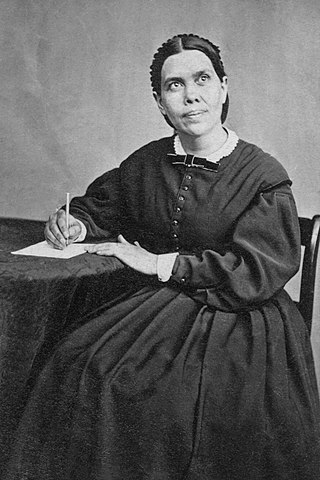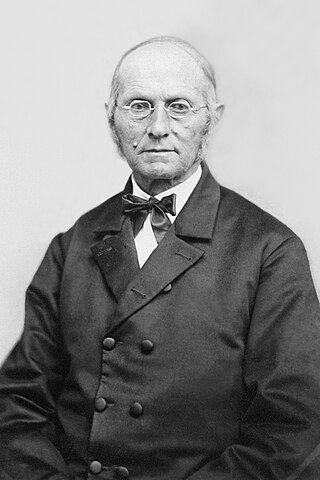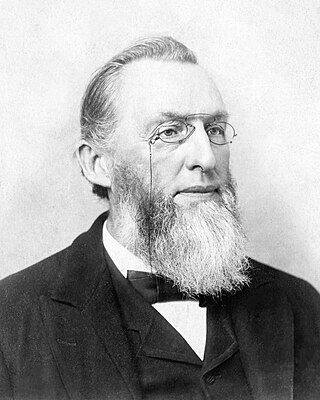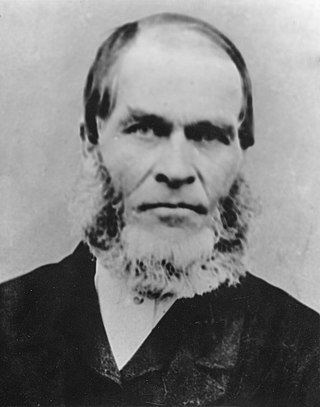Related Research Articles

The Seventh-day Adventist Church (SDA) is an Adventist Protestant Christian denomination which is distinguished by its observance of Saturday, the seventh day of the week in the Christian (Gregorian) and the Hebrew calendar, as the Sabbath, its emphasis on the imminent Second Coming (advent) of Jesus Christ, and its annihilationist soteriology. The denomination grew out of the Millerite movement in the United States during the mid-19th century, and it was formally established in 1863. Among its co-founders was Ellen G. White, whose extensive writings are still held in high regard by the church.

Atkinson is an unincorporated township and former town in Piscataquis County, Maine, United States, and part of the unorganized territory of Southeast Piscataquis, Maine. Its population was 326 at the 2010 census.
The Millerites were the followers of the teachings of William Miller, who in 1831 first shared publicly his belief that the Second Advent of Jesus Christ would occur in roughly the year 1843–1844. Coming during the Second Great Awakening, his teachings were spread widely and grew in popularity, which led to the event known as the Great Disappointment.

Ellen Gould White was an American author and co-founder of the Seventh-day Adventist Church. Along with other Adventist leaders, such as Joseph Bates and her husband James White, she was influential within a small group of early Adventists who formed what became known as the Seventh-day Adventist Church. White is considered a leading figure in American vegetarian history. Smithsonian named her among the "100 Most Significant Americans of All Time".

Joseph Bates was an American seaman and revivalist minister. He was a co-founder and developer of Sabbatarian Adventism, whose followers would later establish the Seventh-day Adventist Church. Bates is also credited with convincing James White and Ellen G. White of the validity of the seventh-day Sabbath.

James Springer White, also known as Elder White, was a co-founder of the Seventh-day Adventist Church and the husband of Ellen G. White. In 1849, he started the first Sabbatarian Adventist periodical entitled The Present Truth, in 1855 he relocated the fledgling center of the movement to Battle Creek, Michigan, and in 1863 played a pivotal role in the formal organization of the denomination. He later played a major role in the development of the Adventist educational structure beginning in 1874 with the formation of Battle Creek College.

The Seventh-day Adventist Church had its roots in the Millerite movement of the 1830s to the 1840s, during the period of the Second Great Awakening, and was officially founded in 1863. Prominent figures in the early church included Hiram Edson, Ellen G. White, her husband James Springer White, Joseph Bates, and J. N. Andrews. Over the ensuing decades the church expanded from its original base in New England to become an international organization. Significant developments such the reviews initiated by evangelicals Donald Barnhouse and Walter Martin, in the 20th century led to its recognition as a Christian denomination.
Dudley Marvin Canright was a pastor in the Seventh-day Adventist Church for 22 years, who later left the church and became one of its most important and credible critics. He joined the church in 1859, at the age of 19, and rose through the ministry to a position of prominence on the General Conference, a committee of Seventh-day Adventist Church leaders.

John Nevins Andrews was a Seventh-day Adventist minister, the first official Seventh-day Adventist missionary, writer, editor, and scholar. Andrews University, a university owned and operated by the Seventh-day Adventist church, is named after him.

Uriah Smith was a Seventh-day Adventist author, minister, educator, and theologian who is best known as the longest serving editor of the Review and Herald for over 50 years.
The Great Controversy is a book by Ellen G. White, one of the founders of the Seventh-day Adventist Church, and held in esteem as a prophetess or messenger of God among Seventh-day Adventist members. In it, White describes the "Great Controversy theme" between Jesus Christ and Satan, as played out over the millennia from its start in heaven, to its final end when the remnant who are faithful to God will be taken to heaven at the Second Advent of Christ, and the world is destroyed and recreated. Regarding the reason for writing the book, the author reported, "In this vision at Lovett's Grove, most of the matter of the Great Controversy which I had seen ten years before, was repeated, and I was shown that I must write it out."
Most Seventh-day Adventists believe church co-founder Ellen G. White (1827–1915) was inspired by God as a prophet, today understood as a manifestation of the New Testament "gift of prophecy," as described in the official beliefs of the church. Her works are officially considered to hold a secondary role to the Bible, but in practice there is wide variation among Adventists as to exactly how much authority should be attributed to her writings. With understanding she claimed was received in visions, White made administrative decisions and gave personal messages of encouragement or rebuke to church members. Seventh-day Adventists believe that only the Bible is sufficient for forming doctrines and beliefs, a position Ellen White supported by statements inclusive of, "the Bible, and the Bible alone, is our rule of faith".
Thomas Motherwell Preble (1810–1907) was a Free Will Baptist minister in New Hampshire and a Millerite preacher. After accepting the teachings of William Miller, Preble was excommunicated from his church.

Hiram Edson (1806–1882) was a pioneer of the Seventh-day Adventist Church, known for introducing the sanctuary doctrine to the church. Hiram Edson was a Millerite adventist, and became a Sabbath-keeping Adventist. Like all Millerites, Edson expected that the Second Coming of Jesus Christ would occur on October 22, 1844. This belief was based on an interpretation of the 2300 day prophecy which predicted that "the sanctuary would be cleansed" which Millerites took to mean that Christ would return on that day.

The seventh-day Sabbath, observed from Friday evening to Saturday evening, is an important part of the beliefs and practices of seventh-day churches. These churches emphasize biblical references such as the ancient Hebrew practice of beginning a day at sundown, and the Genesis creation narrative wherein an "evening and morning" established a day, predating the giving of the Ten Commandments. They hold that the Old and New Testament show no variation in the doctrine of the Sabbath on the seventh day. Saturday, or the seventh day in the weekly cycle, is the only day in all of scripture designated using the term Sabbath. The seventh day of the week is recognized as Sabbath in many languages, calendars, and doctrines, including those of Catholic, Lutheran, and Orthodox churches.[a]
Shut-door theology was a belief held by the Millerite group from 1844 to approximately 1854, some of whom later formed into the Seventh-day Adventist Church. It held that as William Miller had given the final call for salvation, all who did not accept his message were lost. The door of salvation was shut, hence the term "shut door". They later understood it was concerning the sanctuary and not the events on earth so abandoned their earlier understanding. As an interpretation of the year "1844", it was connected to the investigative judgment belief, which forms one of the official 28 Fundamentals beliefs today.
Seventh-day Adventists believe that Ellen G. White, one of the church's co-founders, was a prophetess, understood today as an expression of the New Testament spiritual gift of prophecy.
Ralph Mackin was a Seventh-day Adventist from Ohio, United States. He and his wife claimed to experience gifts of the Holy Spirit such as prophecy, speaking in tongues, and even casting out demons. They caused a stir at a local Adventist camp meeting, which was reported in the local newspaper. They later sought the counsel of Ellen G. White, whom Adventists believe had the gift of prophecy. White was initially cautious regarding their experiences, and later came out opposed to them. After leading some meetings at an Adventist church for a time, they pass from prominence in the church.

George Washington Morse was a Seventh-day Adventist pioneer. As a Millerite Adventist, he experienced the Great Advent Awakening including the Great Disappointment of October 22, 1844. He joined the Sabbath-keeping Adventists in the late 1840s and remained a member until he died 60 years later. He witnessed the SDA Church's development for over a half of a century.
The Seventh-day Adventist Church pioneers were members of Seventh-day Adventist Church, part of the group of Millerites who came together after the Great Disappointment across the United States and formed the Seventh-day Adventist Church. In 1860, the pioneers of the fledgling movement settled on the name, Seventh-day Adventist, representative of the church's distinguishing beliefs. Three years later, on May 21, 1863, the General Conference of Seventh-day Adventists was formed and the movement became an official organization.
References
- 1 2 3 4 Weaver, Bruce (April 1988). "Incident in Atkinson: The Arrest and Trial of Israel Dammon". Adventist Currents. 3 (1): 16–36.
- ↑ Hoyt, Frederick, ed. (August 1987). "Trial of Elder I. Dammon Reported for the Piscataquis Farmer". Spectrum. 17 (5): 29–36.
- 1 2 Schoepflin, Rennie B., ed. (August 1987). "Scandal or Rite of Passage? Historians on the Dammon Trial". Spectrum. 17 (5): 37–50.
- ↑ White, Ellen G. Spiritual Gifts. Vol. 2. pp. 40–42.
- ↑ Campbell, Michael W. "Miles Grant, D. M. Canright, and the Credibility of Ellen G. White: A New Perspective on the Israel Dammon Trial" (PDF). Seventh-day Adventist Church. Retrieved February 27, 2023.